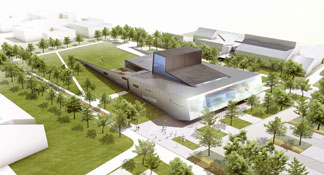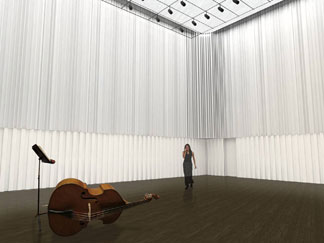Norwegian Firm Draws from Ohio Landscape
 BOWLING GREEN, Ohio — With its flat planes and grass-covered courtyard, the Wolfe Center for the Arts, presently under construction at Bowling Green State University, will remind some of Ohio’s far-stretching prairies and voluminous skies when completed in the fall of next year.
BOWLING GREEN, Ohio — With its flat planes and grass-covered courtyard, the Wolfe Center for the Arts, presently under construction at Bowling Green State University, will remind some of Ohio’s far-stretching prairies and voluminous skies when completed in the fall of next year.Katerina Rüedi Ray, director of BGSU’s School of Art, can see the 93,000-square-foot arts center rising out of the ground just outside her office window one structural beam at a time.
“The building is not monumental in a stylistic sense, but in scale and the simplicity of its form, it’s really quite impressive,” says Ray of the uncompleted structure that will one day provide a permanent home for the school’s Department of Theater and Film, as well as space for BGSU’s visuals arts, music, and dance programs.
Designed by the international architectural firm Snøhetta, of Oslo, Norway, the $41 million building is considered by some to be a work of art, as well as a collaborative space that will allow the school to continue its long-standing tradition of interdisciplinary work.
“The Department of Theater and Film has been waiting for this building for 25 years,” Ray says. “We feel that, although we have been collaborating among the arts for at least 10 years now, this building will usher in a new era of [partnerships] we cannot even imagine.”
Drawing inspiration from the Northwestern Ohio landscape, architects at Snøhetta started their design with a box, the least expensive building form. The box-like building appears half buried into a hillside, providing a second-story front entrance that opens onto a grassy commons area.
“Being Norwegian, the Snøhetta architects have a powerful relationship with the landscape,” Ray says. “When they came to Ohio they were struck by the way the glacial moraines had left large boulders half buried in the ground after the Ice Age retreated, so the concept for the Wolfe Center was of this solid mass rising out of the ground but partly overgrown by nature.”
“That’s what generated the form of the building, which is very different from every other building on campus,” she added.
Built around the school’s 400-seat Donnell Theater, Wolfe Center resembles a sort of “square doughnut,” with the doughnut’s hole serving as the main theater, says Ray.
“A system of corridors surrounds the doughnut hole, or Donnell Theater, on both the first and second floor,” she says. “At the front of the building that circulation system opens up to form the grand lobby of the building, with a semi-grand staircase that can be used like a stage.”
Snøhetta has gained worldwide attention as the designer of the New National Opera House in Oslo; the Library of Alexandria in Alexandria, Egypt; and the National September 11 Memorial & Museum, currently under construction in New York City. Recently, the firm was awarded the redesign of Times Square and the creation of a new wing at the San Francisco Museum of Modern Art.
Ray says BGSU was fortunate to land an accomplished international designer like Snøhetta just as the firm was beginning to make a name for itself in the United States.


“We were extremely lucky to get an architect of international stature before they hit the big time in the U.S.,” says Ray. “Nevertheless, they were happy to work within a Bowling Green State University budget, and our budget is by no means luxurious. Our project will be the first Snøhetta design completed in the United States.”
Snøhetta teamed up with The Collaborative Inc., an architectural firm based in Toledo, Ohio, and with general contractor Rudolph/Libbe Inc. of Walbridge, Ohio, to design and build the Wolfe Center to LEED standards. Another BGSU building, the Stroh Center, is also pursuing LEED status, and is slated for completion around the same time as the Wolfe Center. The buildings will be the first two LEED-certified structures at the college.
Jim Sarks, project architect with The Collaborative Inc., says the Wolfe Center’s LEED status was achieved largely through control and monitoring of indoor air quality. Other green elements include the use of recycled building materials and diversion of about 75 percent of site waste from landfills.
Wolfe Center’s most unique features include a two-story corridor that cuts through the building horizontally, connecting the structure via walkways with the BGSU’s Fine Arts Center and Moore Musical Arts Center, located on either side. Within the Wolfe Center, glass hallways at the “back-of-house” allow people walking through to see into less obvious areas of the theater, like the scene and costume shops.
“The corridor really serves a dual purpose,” explained Ryan Miller, project manager for BGSU’s office of design and construction. “One, within the center’s main theater it helps divide “front-of-house” activities from “back-of-house” action. Two, it serves as a walkway that essentially aligns the building with the entrances of arts facilities located on either side. In addition to working as a shortcut, the walkway gives students from other colleges a chance to glimpse into what’s going on in BGSU’s arts program.”
Ray says the space, which has been nicknamed “the Highway,” will become a major gathering place and a Wolfe Center hub for students and faculty of BGSU’s arts program.

When completed, the Wolfe Center will incorporate some of the latest design and performance art technologies, including a tall, vertical “fly tower” above the main theater that will allow for the use of more extensive scenery and backdrops than is typical in campus theaters.
In a separate actors theater, located within the building, a series of platforms can be raised or lowered independently with pneumatic scissor lifts to create an arena, thrust or end stage. On the center’s second floor, computers labs used by the school’s Digital Arts division will allow for the production of high-end digital videos, animation, sound and graphics, and virtual environments.
The Wolfe Center will house offices for professors and graduate students of the Department of Theater and Film. Visually interpreting the collaboration between the college and Snøhetta, a 90-foot-by-30-foot photographic mural created by a Norwegian-American artist will be installed on the exterior wall of Donnell Theater. The mural will be the largest public art work in Ohio, says Ray.
BGSU has approximately $200 million in construction projects underway on campus, says Miller. Projects include renovations to the College of Health and Human Services Building, development of two new residence halls, and the building of a new dining area, as well as construction of the Stroh Center.
